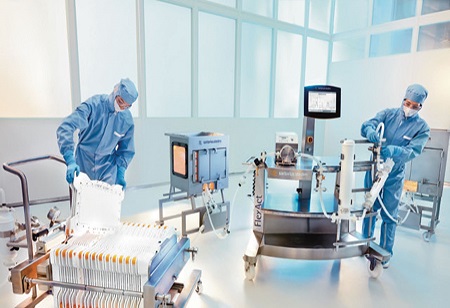Janifha Evangeline | Friday, 05 August 2022

The market for single-use technologies in biopharmaceutical manufacturing is anticipated to reach USD 7.3 billion by 2026. Contract manufacturing organizations or CMOs are searching for better as well as highly innovative strategies, continually with an aim to maintain a competitive edge in biologics manufacturing. The speed of single-use equipment adoption by Contract manufacturing organizations is outpacing the speed of biopharma innovators for small and mid-scale bioprocessing, as per the 16th Annual Report and Survey of Biopharmaceutical Manufacturing Capacity and Production, & it is being used for larger-scale commercial manufacturing at an increasing rate. For instance,
Contract manufacturing organizations, than bio-developers are more likely to adopt single-use bioreactors, at a rate of eighty-seven percent versus just less than eighty percent which will let them stay competitive. This is in particular with Research and Development & clinical trials, with higher efficiency & at a lower cost. Continued progress & market expansion across the biopharma industry is anticipated owing to the advancement of technology, knowledge & experience in the single-use field.
Adjacent industries are also witnessing expansions as well as adaptations, which have been implemented in mainstream biologics production, other than continuous progress in the biopharma industry. The production of cosmetics & food derived from plant cell & tissue cultures and cell & gene therapy is now occurring at manufacturing scales. The single-use equipment which are generally manufactured using plastic parts sterilized by gamma radiation is used once and then discarded when compared to traditional equipment.
The advantages of single-use versus fixed stainless steel have been demonstrated including lower capital investment & operational costs and greater flexibility, over more than a decade of combined industry experience. Bioprocessing & progressive manufacturing of numerous products at multiple scales in the same areas can be set up rapidly with Single-Use Systems. Also, product lines have expanded to complex bioreactors from basic storage bags, with an aim for all bioprocessing, particularly upstream can be done with single-use systems.
Industry trends in Single-use systems Availability of Single-use bioreactors with larger scale Single-use bioreactors & mixers are now available at less than or equal to 2000 L scale, while only a few single-use systems, that were generally limited to 100 L were available before two decades. Owing to engineering limitations, systems above 2000 L are present but they are generally neither practical nor cost-effective. 1000 L bioreactors are on track to become the industry standard
for new product large-scale and much commercial-scale manufacturing as several enterprises render an expanding range of product options.
Yposkesi – performs process evaluation & optimization in bioreactors with capacities of two liters to 10 liters & for scale-up experiments up to 200 L. The French contract developer, as well as manufacturer of gene therapies, uses a single-use bioreactor With single-use at about fifteen percent, the Stainless-steel facilities still dominate, and these account for about eighty-five percent of the market, and the proportion is anticipated to shift to about seventy to seventy-five percent stainless and twenty to twenty-three percent single-use, including growth in the Single Use System market of up to three hundred percent, over the next 5-10 years.
Adopting major bioprocessing systems Simpler devices are the most frequently used single-use products either at any stage or on any scale. These devices include filter cartridges, bags & tubing. However, it is important that most of the facilities are adopting major bioprocessing systems, while nearly eighty percent use bioreactors, more than seventy percent use mixers & nearly seventy percent use tangential flow filtration.
New Horizon Biotech, a US-based company develops a patented fermenter system for flexible & cost-effective biopharmaceutical production. SUHF also known as a single-use horizontal fermenter is a pressurizable, low-volume modular & scalable fermenter, which features a bag retention vessel & agitation impellers and aerators. Eliminating cleansing requirements, reducing the time to get a facility up & running, reducing capital investment in facilities & equipment, decreasing the risk of cross-product contamination, & allowing flexibility with a modular approach are some of the reasons why respondents considered it important for adopting single-use systems.
Other advancements promote growth in SUS adoption Another important and growing trend in this field is modular facilities. The complete portable manufacturing facilities can be constructed & can be operational in a matter of months or even weeks with processes housed in connectable, portable cleanrooms or isolator units. The market is anticipated to grow dramatically, with modular systems using Single Unit System equipment & offering much the same advantages as SUS. This comprises plug & play factories with complete production lines & facilities fully cloneable.
OmniBRx offers disposable bioreactors which are run within minutes by a single worker. This allows for operational flexibility which in turn leads to a reduction in the time-to-time market & an increase in profit margins. This Indian startup offers single-use assembling & other bioprocessing solutions.
The road ahead Products now in development using single-use systems are moving up to commercial manufacturing and therefore, the fastest growing sector of the single-use equipment market is upstream bioprocessing at large & commercial scales. The increasing requirements for better, cheaper as well as faster biologics production, globally are set to define the future for Single Use System technologies.